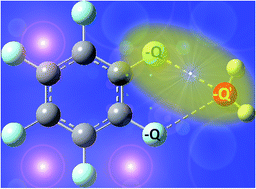Can an entirely negative fluorine in a molecule, viz. perfluorobenzene, interact attractively with the entirely negative site(s) on another molecule(s)? Like liking like!†
Abstract
We present in this study the possibility of the formation of attractive intermolecular interactions between various entirely negative sites localized on a variety of atoms in molecules, leading to the formation of the thirteen isolated dimers examined. Each of these dimers is formed upon the attractive engagement of the totally negatively charged, covalently bound fluorine in perfluorobenzene (C6F6) with similarly charged atoms in each of the nine Lewis bases selected, e.g., water (H2O), ammonia (NH3), hydrogen fluoride (HF), formaldehyde (H2CO), fluoromethane (H3CF), fully fluorinated pyridine (C5F5N), pyrimidine (C4F4N2), pyrazine (C4F4N2), and pyridazine ((CF)4N2). The uncorrected binding energies (varying between −0.45 and −2.56 kJ mol−1 with CCSD(T)/6-311G**//M06-2X/6-311++G(d,p)) and intermolecular contact distances (varying between 2.988 and 3.559 Å with M06-2X/6-311++G(d,p)) calculated for these dimers are found to be close to what might be envisaged for any weakly bound dimers, viz., dimers of alkanes and polyhedranes that involve C–H⋯H–C dihydrogen bond contacts with bond dissociation energies in the 0.52–12.38 kJ mol−1 range (Nat. Chem., 2011, 3, 323). The topological charge density results obtained upon the application of quantum theory of atoms in molecules and reduced density gradient noncovalent interaction tools to the static geometries of all the thirteen dimers examined have enabled us to demonstrate that the Oδ−⋯Fδ−, Fδ−⋯Fδ−, and Nδ−⋯Fδ− intermolecular contacts revealed are closed-shell type. The calculated (negative) signs and magnitudes of the electrostatic potentials at various local minima and maxima on the surfaces of the ten monomers examined do not support the above possibilities of attraction between the entirely negative sites, thereby revealing a limitation of the model.


 Please wait while we load your content...
Please wait while we load your content...